How to make the perfect country pâté
Would you splash out on mincing and sous-vide machines in pursuit of the perfect pâté de campagne? Order pig fat and offal from the butcher? Or just pop to the supermarket for some Shippam's meat paste?
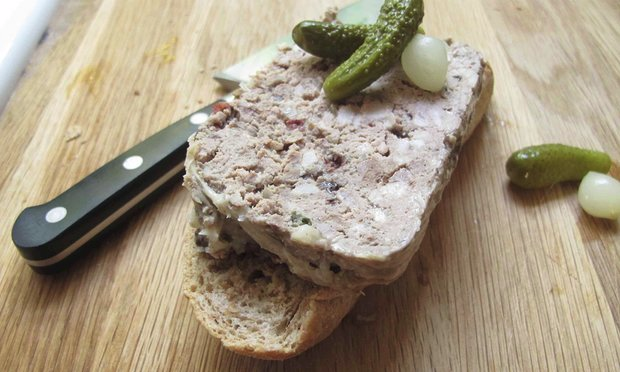
Perfect country pâté. Photographs: Felicity Cloake for the Guardian
I must confess that I've been avoiding pâté de campagne. It's not that I don't like the stuff – loaded on to hunks of bread in great meaty wodges, it's a pretty unbeatable lunch – yet I had a sneaking suspicion that making it myself wasn't going to be quite as easy as knocking up a silky chicken liver or a creamy smoked mackerel pâté. A coarsely textured terrine of pork, offal and fat seemed a more daunting proposition, somehow.
For a start, pâté de campagne contains all sorts of mysterious chunks beneath its jellied crust which I rightly surmised would be hard to come by in 21st-century Britain. For another, I had a horrible feeling I might need to invest in a mincing machine. Admittedly, this gadget had been on my list for some time, ever since I embarked on the perfect burger and discovered how inconsistent supermarket mince could be, but still, it wasn't a project that was going to be doable in an afternoon. So is homemade pâté de campagne worth the effort, or is it one of those dishes best left to the professionals?
The meat
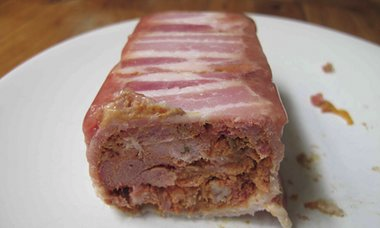
Our Daily Brine's pate de campagne. Photograph: Felicity Cloake/Guardian
As Julia Child explains in Mastering the Art of French Cooking, pâté de campagnes "vary in content and flavour throughout France, but always contain pork liver, pork, and sometimes other meats, as well as pork fat, a binder and the usual seasoning".
Pork shoulder, a flavourful cut well marbled with fat, is the most popular base in the pâté recipes I try, used by Raymond Blanc's Foolproof French Cookery and Anthony Bourdain's Les Halles Cookbook. Michel Roux's The Essence of French Cooking suggests pork neck and Julia Child "fat-and-lean fresh pork" such as sausagemeat. Blanc also uses pork belly and Child adds lean veal or chicken. I suspect Blanc's pork belly is a goodwill gesture towards his readers, because almost all the other recipes use pork fat, which is somewhat more difficult to get hold of on its own, though your butcher should be able to find you some if you give him or her notice. (He and Our Daily Brine, the other recipe to omit it, also add bacon to the mixture, which helps to up the fat content.)
I think that, sadly, some pure fat is essential – it gives the pâté a surprising lightness of texture particularly evident in Roux and Bourdain's versions, without adding too much salt, as the bacon tends to. Pork shoulder, which is far easier to get hold of than pork neck, will form the bulk of the pâté. Roux and Bourdain both marinate their meat overnight before use, which definitely seems to help in the flavour department if you've got the time; this is not instant gratification. Blanc whizzes his meats up in the food processor, which I'd love to say works just fine, but in fact makes it rather mushy; you need to mince it, preferably fairly coarsely, to give that authentic chunky texture. As you're going to have to go to the butcher anyway, ask him to do the hard work for you.
The offal
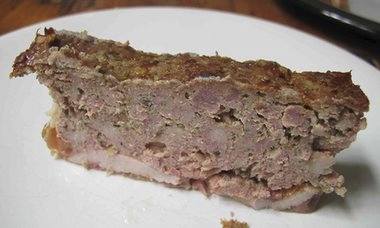
Michel Roux's pate de campagne. Photograph: Felicity Cloake/Guardian
That's not all, though – a great variety of offal goes into pâtés, as befits their rustic roots. Blanc, Bourdain and Roux use pig's liver, Child and Our Daily Brine calf and chicken liver respectively, and the last also pops in a pig's kidney for good measure. I'm not sure the kidney contributes much to be honest, unless you've got one in need of using up, but the slightly sweet, earthy flavour of liver is essential. The stronger flavoured pig's version worked better with the other porky ingredients, if you can find some (and given you'll probably have to order in the pork fat, asking for this too shouldn't be a problem), but if not, substitute the subtler chicken variety instead. (And, should you be put off by the notion of a strongly flavoured liver, if you like French pork pâtés, you'll like it, trust me.)
Binder
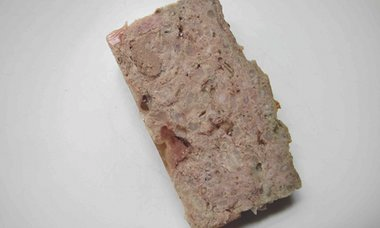
Julia Child's pate de campagne. Photograph: Felicity Cloake/Guardian
Child makes a rice "panade" to bind her pâté – rice cooked with butter and stock, then minced along with the rest – but egg alone is a more common choice. Roux and Our Daily Brine also add double cream, which gives the whole thing a really gorgeous richness. This is a special occasion dish, after all, so we may as well push the boat out.
Spices
Sweet spices are a popular choice, with Roux and Our Daily Brine using nutmeg and cloves, and Roux popping in ginger and Our Daily Brine mace, while Blanc puts in Chinese five-spice and juniper berries, and Bourdain and Child allspice. Our Daily Brine adds a generous amount of piment d'espelette, which, though it works well with the pork, I find a bit strident in flavour and colour. My testers also observe that they've been too generous with the salt – I'm not shy of the stuff, but you should be able to taste the sweetness of the meat and spice too. I settle on Roux's nutmeg, ginger and cloves as a well-rounded, warming combination.
Other flavours
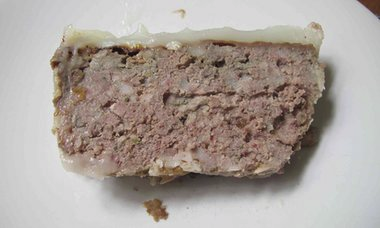
Anthony Bourdain's pate de campagne. Photograph: Felicity Cloake/Guardian
Most people add garlic and either onions or shallots – I prefer the sweetness of the shallot to the sharper onion, especially when softened in butter as Child and Roux suggest. Herbwise, aromatic thyme seems more in keeping with the rest of the flavours than Bourdain's peppery parsley.
Roux, Bourdain and Blanc all put white wine into their terrines, with Blanc, Bourdain and Our Daily Brine putting in some cognac for good measure. I like the stronger, sweeter flavour of the brandy; it seems more luxurious and again, country or not, this isn't a dish you're going to make every day. Our Daily Brine, which has a brilliantly geeky post on the serious business of pâté, mentions that many recipes deploy what they refer to as "an interior garnish … nuts, such as walnuts or pistachios, dried fruits such as cherries, figs or apricots, or the classic and coveted truffle".
They and Blanc nominate pistachios, which look pretty, though I'm not too keen on them with the other flavours here. They find more favour with some of my testers. They also use green peppercorns, which, though their colour is less vivid, work far better – you could go for the pink variety if you're feeling particularly jaunty.
Cooking
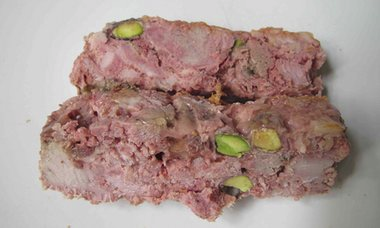
Raymond Blanc's pate de campagne. Photograph: Felicity Cloake/Guardian
Our Daily Brine lines the terrines with bacon, Child and Roux with more pork fat and Bourdain with caul fat, the peculiarly beautiful lacy membrane that comes wrapped around the stomach of animals including pigs. This is super easy to use, as it comes in large sheets, but as long as you use some sort of fat to aid the turning out of the terrine, it doesn't matter whether it's caul, strips of back fat or just lard. Bacon looks pretty, but such long, slow cooking renders it chewy and disappointing. Bourdain also tops his with duck fat, which provides a helpful seal, but proves rather unpleasant at room temperature.
Traditionally, pâtés are baked in a bain-marie to moderate the temperature and prevent them overcooking and drying out. Cleverly, Our Daily Brine suggests using a sous-vide machine as a modern alternative, explaining that "one of the benefits of sous vide, literally 'under vacuum', is that a vacuum is used to seal and compress the farce – both as it cooks and as it cools. Additionally, sous vide allows for more precise cooking; we are able to set the water bath to a precise 65.5C and cook the pâté to equilibrium."
As I'm lucky enough to have a sous-vide machine leftover from (what else) perfect fried eggs, I give this a try with half their mixture, and find that indeed the results hold together better than their oven-baked counterparts. It is certainly more precise, given the inevitable fluctuation in oven temperatures, but rest assured that you don't need to splash out on one; the traditional method works just fine too. Make sure you weight down the terrine after cooking to compress the pâté, though. Blanc reckons this is "best prepared about two days in advance, so the flavours have time to mature", and he's right – it'll keep for at least a week in the fridge. In theory, at least.
The perfect country pâté
(Serves 10)
- 500g pork shoulder, coarsely minced
- 250g pork back fat, minced
- 250g pig's liver (or chicken), minced
- 5 tbsp brandy
- ¼ tsp ground ginger
- ¼ tsp ground nutmeg
- ¼ tsp ground cloves
- ½ tsp freshly ground black pepper
- 2 sprigs of thyme, leaves only, chopped
- 2 cloves of garlic, crushed
- Knob of butter
- 2 shallots, finely chopped
- 1 egg, beaten
- 2 tbsp double cream
- 1 tsp salt
- 2 tbsp green peppercorns
Caul fat, extra back fat cut into thin strips, or lard, to line the dish
Put the mince in a large bowl and sprinkle with the brandy, spices, thyme and garlic. Mix well, cover and refrigerate overnight, removing from the fridge an hour before going on to step two.
Melt the butter in a small frying pan and cook the shallots over a gentle heat until soft. Stir this into the meat mixture along with the egg, cream, salt and peppercorns.
Heat the oven to 170C/325F/gas mark three and boil the kettle. Fry a small blob of the mixture in the pan to check the seasoning and adjust if necessary. Line a 20x10x6cm terrine dish or loaf tin with fat and spoon in the mixture. Cover tightly with foil or greaseproof paper and put in a roasting tin on the middle shelf of the oven. Pour in boiling water to two thirds of the way up the terrine.
Bake for about 70 minutes until the internal temperature reaches 65-70C or until a skewer inserted into the centre comes out warm all the way through. Put a plate on top of the terrine, weigh down with a couple of tins and allow to cool. Refrigerate, still with the tins on top, at least overnight, before serving.
Pâté de campagne: best meat paste ever, or not a patch on Shippam's? What is your favourite style of pâté, and is it one dish you would prefer to leave to the professionals?